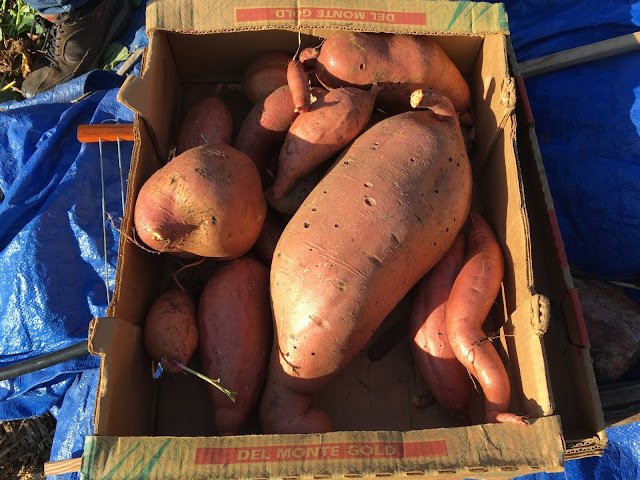Beauregard tips the scales at Horticulture Center
 |
| That's a 10.5-pound sweet potato in the center, part of the Horticulture Center's harvest (Photos: Kathy Morrison) |
 |
Master Gardener Gail Pothour talks about the
straw bale garden and sweet potatoes. |
By Kathy Morrison
For all the activity in every corner of the Fair Oaks Horticulture Center on Wednesday, the buzziest area was in the vegetable garden — specifically, the straw bales where the sweet potatoes were planted.
It was harvest time during the Open Garden event, and UCCE Master Gardener Gail Pothour and her crew were busting down the bales. The pride of the harvest was a whopper of a Beauregard sweet potato that weighed in at 10 1/2 pounds. Think bigger than your average newborn baby, or about the size of a small dog. Everyone who came by exclaimed at the size.
That sweet potato will make some fine eating after it’s cured a couple of weeks, allowing the starches to turn to sugar. Unlike some root crops, Pothour says, sweet potatoes don’t become woody as they get larger. The only concern is if a sweet potato develops “veins” on the outside; they have to be trimmed off. The big one -- dubbed Taterzilla -- didn’t have veins, but some of the others in the 57 pounds harvested did have them. In addition to the Beauregard variety, the straw bales also had some Nancy Hall sweet potato plants.
 |
Here's what the straw bales looked like in mid-May, just
after the sweet potato slips were planted.
|
The master gardeners have experimented with different crops in straw bales over the past few years, but this is the first time for sweet potatoes. The method has become popular as an alternative to raised beds: At the end of the season, the remaining straw becomes mulch for other parts of the garden.
The three bales used this year were wheat straw, which is less common in our region -- most of the ones you see sold are rice straw, Pothour says. But the master gardeners have found that wheat ones hold up better over the season.
Augmented with potting soil and heavily watered at first, the softened straw allows roots to grow more easily than in our typical clay soil. Pothour says carrots also have done well in straw bales.
 |
In early August, the sweet potato vines covered
the bales and most of the trellis.
|


Comments
Post a Comment